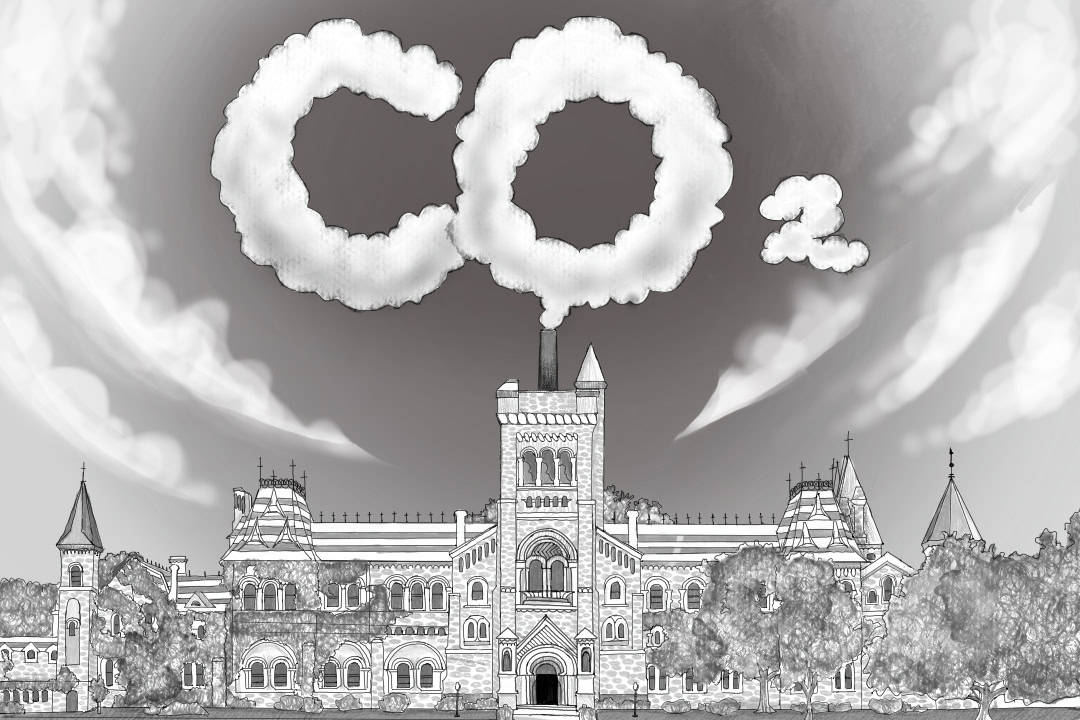In July, a group of researchers at U of T published a report quantifying the results of U of T’s climate initiatives between 2017 and 2023.
After UTSG took its commitment to becoming climate positive three years ago, UTM and UTSC joined the initiative in 2023. UTM released their report but UTSC has yet to do so.
The Varsity broke down the Carbon Emissions Report and U of T’s commitment to have net zero emissions by 2050.
Climate Positive Plan
UTM’s Climate Positive Plan outlines three key areas where the campus can improve green initiatives: energy consumption, energy distribution, and energy production.
To address energy consumption, UTM plans to introduce energy conservation measures such as heating, ventilation and air conditioning, lighting, and building doors, windows, walls, and roofs. For energy distribution, UTM plans to convert all steam boilers to electric hot water. To produce net positive energy by 2050, UTM plans to continue investing in renewable energy sources — such as solar and wind energy. The plan also includes UTM’s first geothermal system.
The Climate Positive Plan for UTSG focuses on transforming infrastructure and energy systems to reduce greenhouse gas emissions by at least 80 per cent. There are three main goals — “Growth, Renewal and Resiliency” — through which U of T can accomplish its mission of having net zero emissions by 2050.
The first goal is to double U of T’s research, teaching, and community facilities over the next 30 years while minimizing energy use, carbon emissions, and water consumption. Additionally, they will set a strict carbon budget for any new construction projects and expand district energy — a system that distributes thermal energy into buildings within a larger area or a whole neighbourhood — to meet campus needs.
The second goal is to renew aging infrastructure to ensure future performance, longevity, and compatibility with sustainable technologies. By eliminating steam generation, switching to renewable energy, and upgrading generation and distribution systems, the university aims to reduce the carbon footprint and energy consumption of its buildings.
The third goal is to build resilient energy infrastructure and technologies. U of T has designed several initiatives to establish long-lasting infrastructure, which includes replacing fossil fuels with electricity to generate thermal energy, creating a network of interconnected thermal and electric energy redistribution nodes, and implementing low-carbon technologies.
U of T President Meric Gertler described the Climate Positive Plan as “a regenerative approach to sustainability that is befitting of an institution dedicated to making the world a better place.”
The Carbon Emissions Report
The carbon emissions report from July quantified U of T’s greenhouse gas (GHG) emissions from 2017 to 2023. The report used the international standard GHG Protocol, which classifies emissions into Scope 1, Scope 2, and Scope 3. Scope 1 includes direct emissions from buildings owned and controlled by U of T. Scope 2 looks at indirect emissions from electricity, heat, and steam to power buildings. Scope 3 looks at indirect emissions that arise from U of T activities such as student and faculty commute, equity investments, or laboratory work. The Climate Positive Plan focuses on initiatives to reduce Scope 1 and 2 emissions.
In 2023, U of T emitted a total of 526,098 tonnes of carbon dioxide-equivalent emissions, with Scope 1 and 2 emissions contributing to 20 per cent of the total emissions. This is the lowest amount of Scope 1 and 2 emissions produced together since 2017. Scope 3 emissions constituted the other 80 per cent of 2023 emissions, which were the highest compared to the yearly amounts from the last seven years.
Emissions from fuel and energy went down from 47,490 tonnes of carbon dioxide equivalent in 2017 to 44,902 in 2023. Emissions from waste management and transportation show a similar downward trend. The report highlighted that targeted intervention in these areas has had a significant impact.
The findings stressed the need for ongoing efforts like the Climate Positive Plan to reduce carbon emissions. Additionally, it concluded that assessments of data were crucial to stay on track for U of T’s net-zero emissions goal.



No comments to display.